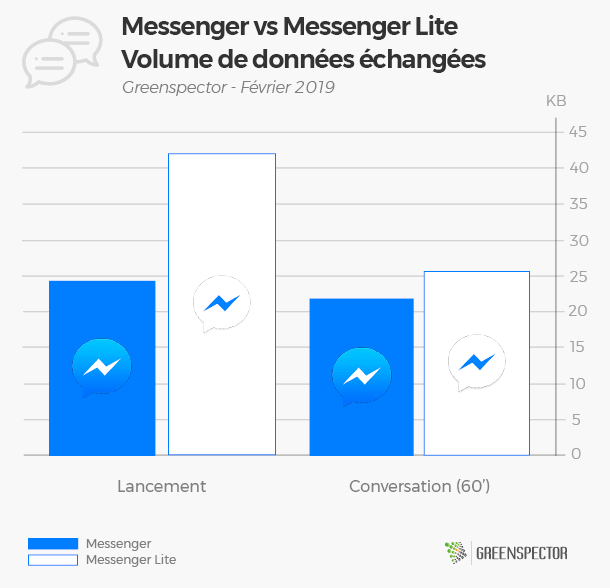Note: Find our other comparative articles of lightened apps: Facebook vs Facebook Lite or Instagram vs Instagram Lite.

Messenger’s parent company Facebook launched its lightweight Messenger Lite version in 2016, originally intended for developing countries that don’t have stable, powerful connectivity or state-of-the-art smartphones. Nevertheless, success is also evident in developed countries where the connection in some regions is low. Facebook has made the choice to deploy Facebook Lite and Messenger Lite in other countries including countries of Europe.
If the first version offered only few possibilities in terms of functionality, it was enriched during the year while maintaining its promise of a lighter version: less data exchanged on the network, less memory occupied, fewer resources engaged on the smartphone. This is what we will check in this article comparing the traditional version of Messenger to its light Messenger Lite version.
Messenger is an instant messaging app launched in 2011 incorporated into the Facebook social network. It’s the most popular messaging application in the world with nearly 1,500 million monthly active users. It allows you to send messages, photos, videos, gifs, but also to make audio and video calls.
Results
| Application | Version | Downloads | Playstore grade | App weight (MB) | Process data (KB) | Memory (MB) | Autonomy impact (mAh) |
|---|---|---|---|---|---|---|---|
| Messenger | 201.0.0.12.99 | 1 000 000 000+ | 4.1 | 45 | 25.46 | 276.73 | 8.08 |
| Messenger Lite | 51.0.1.12.216 | 100 000 000+ | 4.4 | 24.38 | 41.94 | 82.66 | 7.76 |
From the point of view of the weight of the application, the promise of Messenger Lite is respected. Indeed, the weight of Messenger Lite (24.38 MB) is 1.8 times lower than that of the traditional version of Messenger (45 MB).
Data consumption comparison

The amount of data exchanged on the network is less important on the traditional version of Messenger than that Lite one, a difference of almost 1.6 times lower for launch and inactivity phases. For the conversion phase, Messenger Lite has a volume of 25.62 KB against 21.79 KB for the traditional version (+ 15%).
We note that the data management isn’t good for Messenger Lite and the promise isn’t held at that level. In addition, the two applications could improve their cache management.
Memory consumption comparison
Concerning the volume of memory, here Messenger Lite stands out with its busy memory of 82.66 MB against 276.73 MB for the traditional application. The promise of lower occupied memory is therefore respected.
Energy consumption comparison

Messenger Lite’s power consumption is lower than Messenger. Regarding the launch phase, Messenger Lite (2.79 mAh) displays a consumption 13% lower than the traditional version (3.22 mAh).
The difference is more obvious during the chat phase (which here lasts 60 seconds), where Messenger Lite (10.91 mAh) consumes 10% less than Messenger (12.11 mAh).
It’s the same for the phase of inactivity in the foreground (2.73 mAh against 2.84 mAh) and the phase of inactivity in the background (1.76 mAh against 1.87 mAh).
Conclusion
The promise of the lightened version is only partially respected, indeed an effort is to be made concerning the volume of data exchanged. By using Messenger Lite you will use less battery but will consume more data on the network. The choice is difficult: prefer to consume less battery or less data? With the Lite version you will consume less storage space, less memory, if your priority is to consume less battery, download the lite version. However, if you are one of the users who have an expensive data plan or a bad network connection, prefer the traditional version which will save you in terms of data exchanged. This choice between energy and data surely comes from the fact that the designers of applications don’t take energy as an important criterion. Too bad because it would be possible for the user to consume both less data AND less energy.

